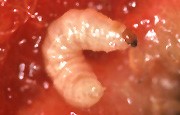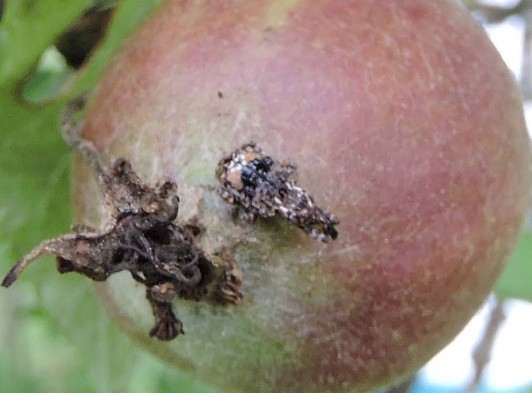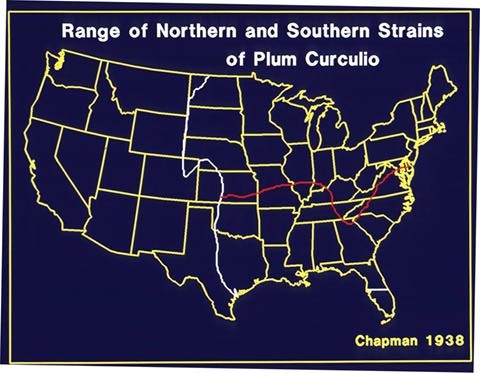By Douglas G. Pfeiffer, Dept. Entomology, Virginia Tech, Blacksburg VA 24061


Usually thought of as apple, peach, cherry and plum pest but plum curculio also will attack blueberry, huckleberry, grape, and persimmon (Milholland & Meyer 1984). Plum curculio is one of the most potentially damaging pests on various hosts during the petal fall period. The biology of PC is similar for most deciduous fruits, although the timing may be slightly different. The adults overwinter in the top few inches of leaf litter in nearby hedgerows, trashy fields and woods (especially on the south edge of a fruit planting). The adults initially appear in orchards during bloom. Most beetle activity occurs during the first warm period after petal fall, when the maximum temperature is 70°F or higher. Periods of cool, rainy weather with maximum temperatures below 70°F are not suitable for adult activity. Adults can be found in orchards for 5 to 7 weeks.
Egg laying activity starts once the fruit begins to form, with egg hatch occurring after 7 days. In successfully attacked hosts, the hatching larva burrows into the fruit’s center, where it makes large irregular cavities. Fruit that are successfully attacked by larvae are prone to drop prematurely. After 14-16 days within the fruit the larvae exit and enter the soil where they form a pupation chamber for an additional 10-12 days before transforming into adults. New adults can appear in the orchards in mid- to late- July with emergence continuing until early September. In September and October adults begin seeking overwintering quarters. There is only one generation per year in the mid-Atlantic region. There is a second generation in eastern Virginia and southward.
Adults become active when average daily temperatures near 10-15°C (50-60°F) for 2 or more consecutive days and high temperatures are 24°C (75°F) for 2 or more consecutive days (Milholland & Meyer 1984). Plum curculio is often active when early blueberry varieties are beginning to bloom (Marucci 1966). Females oviposit in fruit, leaving crescent-shaped scars. Larvae develop in fruit, over about a 2-week period. Infested berries turn blue prematurely, often dropping to ground before uninfested berries turn blue. A few late-maturing larvae may reach market (Marucci 1966). Most of the adults produced enter diapause, but a few mate and produce a second generation in the south (Mampe & Neunzig 1967). Reissig et al. (1998) reported that injury progressed faster and ended earlier in smaller apple trees than larger trees, probably because of differences in tree architecture; this may relate also to a relatively small host plant as blueberry.
A note on plum curculio strains. There are two strains of plum curculio. The northern strain has an obligatory chilling requirement. Therefore, there is a single generation per season. The southern strain lacks this chilling requirement and can develop two generations seasonally. A rough map showing the distribution of the northern (single-brooded) and southern (double-brooded) strains was developed by Chapman (1938). There are genetic differences among geographic strains of PC (Zhang et al. 2008). Furthermore, there are Wolbachia symbionts in PC, also with geographical differences in their genetics (Zhang et al. 2010). These differences in Wobachia infections likely result in observed differences to mate within and among PC strains (Zhang and Pfeiffer 2008).

Plum curculio may be monitored by shaking branches over a sheet. Examine fruit for fresh injury, especially on borders adjacent to woodlands. Two applications of a contact insecticide are usually necessary (Milholland & Meyer 1984); first when adults begin to return to field; second timed to end of migration period, when max. temps. reach 32oC (90oF) (Milholland & Meyer 1984). Imidan is very effective; check the Southern Region blueberry bulletin or state recommendations for additional alternatives.
Additional Reading:
Amiss, A. A. and J. W. Snow. 1985. Conotrachelus nenuphar. p. 227-235. In: P. Singh and R. F. Morse (eds). Handbook of Insect Rearing. Vol. 1. Elsevier NY. 488 p.
Mampe, C. D. and H. H. Neunzig. 1967. The biology, parasitism, and population sampling of the plum curculio on blueberry in North Carolina. J. Econ. Entomol. 60: 807-812.Reissig, W. H., J .P. Nyrop & R.
Straub. 1998. Oviposition model for timing insecticide sprays against plum curculio (Coleoptera: Curculionidae) in New York State. Environ. Entomol. 27: 1053-1061.
Zhang, X., S. Luckhart, J. Tu and D. G. Pfeiffer. 2010. Analysis of Wolbachia strains associated with Conotrachelus nenuphar (Coleoptera: Curculionidae) in the eastern United States. Environ. Entomol. 39: 396-405.
Zhang, X., J. Tu, S. Luckhart and D. G. Pfeiffer. 2008. Genetic diversity of plum curculio, Conotrachelus nenuphar (Herbst) (Coleoptera: Curculionidae) among geographical populations in the eastern United States. Ann. Entomol. Soc. Am. 101: 824-832.
Zhang, X., and D. G. Pfeiffer. 2008. Evaluation of reproductive compatibility of interstrain matings among plum curculio populations in the eastern United States. Environ. Entomol. 37: 1208-1213.v